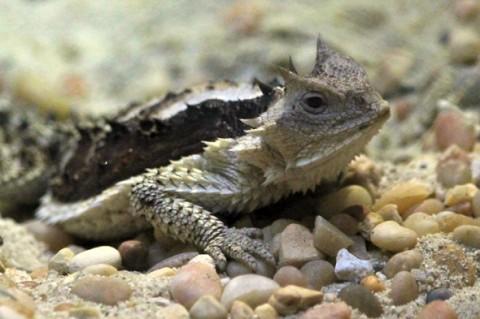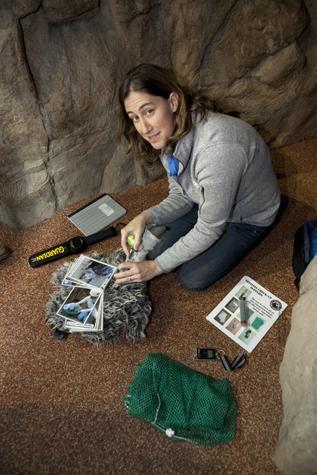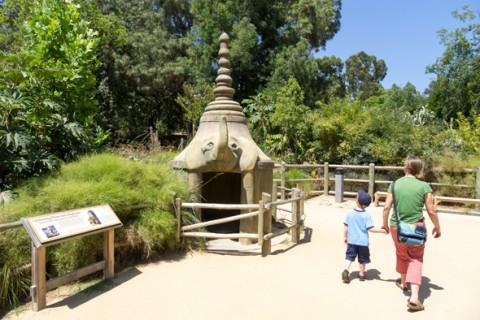Towards the end of my Curious Traveler road trip[1] last summer, I promised myself I’d spend more time exploring my own backyard. So when I learned that my friend Samantha Cadman had been hired as a bird keeper at the L.A. Zoo[2], I jumped at the chance to hit her up for a behind-the-scenes tour. (Samantha and I volunteered together at the Santa Barbara Zoo[3] during college, which essentially meant we’d bonded while shoveling poop.)
Despite growing up in Southern California, I had never been to the Griffith Park[4] mainstay. Turned out it isn’t just locals who turned a blind eye. “When people come to L.A., they go to Hollywood, they do the celebrity and night club deal, they shop on Rodeo [Drive], maybe visit the Getty. Not many people think of going to the zoo,” Samantha lamented as we parked near the entrance.

A clutch of giant horned lizards hatched at the L.A. Zoo in 2010, marking the first time the species has ever reproduced in a North American zoo. (Photograph by Loren Javier, Flickr)
Samantha deposited me at the LAIR[5] (Living Amphibians Invertebrates Reptiles), the newest herpetarium in the U.S., to meet Jason Jacobs, the zoo’s director of public relations, and Ian Recchio, the curator of reptiles and amphibians.
Inside, the stylish building pulsed with energetic kids and parents trying to keep pace. Recchio gestured toward the floor-to-ceiling exhibit space which, he said, was designed so ”kids can really get nose to nose with the critters.” He asked me if I’d like to see the archer fish[6] hunt crickets, and I responded with an enthusiastic nod.
When he placed a handful of the insects on a log perched above the pond’s surface, I wasn’t sure how the fish would reach them. Until, that is, they began spitting jets of water at the log, knocking the unwitting prey into their jaws. Kids gathered around, some giggling with delight, others yelling “Ewwwwww, gross!”
Recchio spoke of each animal we passed the way a brother might speak of his siblings, outlining each one’s personality quirks. “These guys are so cool!” he exclaimed with the enthusiasm of a young boy as he pointed out the giant horned lizards[7] from West Mexico. “They squirt blood out of their eyes and eat ants!” Then he snapped back into keeper mode and added: “We know very little about this species. They represent hundreds of animals at the zoo that are data deficient.”
After the tour, Jacobs and I set off in an electric cart for our next destination, passing koalas, Grévy’s zebras, and the six-acre “Elephants of Asia” exhibit as we zipped along munching on a bag of the zoo’s addictive kettle corn. “This is a part of the zoo most visitors don’t see,” he confided, “but it’s critical to our conservation mission.”
When we reached the top of a hill, we had entered California Condor Country.
The zoo’s chief veterinarian, Dr. Curtis Eng, greeted us warmly, then started to explain why condor conservation had become such a big priority. In the early 1980s, there were fewer than two dozen California condors left in the wild. The zoo responded by launching a breeding and re-release program in cooperation with other stakeholder organizations and agencies.
Eng told us that the keeper had a condor out and was treating its injured wing. “We can’t go in there, but come take a peak.”
Through the cracked door, I saw a black figure perched on a stand in the center of the circular office. The breath caught in my throat. I knew condors were big, but she was massive. When I asked why condors were on the brink of extinction, Eng’s answer surprised me.
Lead poisoning.
He explained that lead-based ammunition is the biggest threat facing condors in the wild. The birds aren’t shot directly; lead bullets shatter when shot, so when hunters clean their quarry, they end up leaving potentially fatal gut piles behind. “We currently have 22 condors, but the number is fluid, as birds with lead toxicity are brought in, treated, and released,” Dr. Eng said.
Despite these pitfalls there are currently about 400 condors alive, with nearly 230 roaming the skies. “Now wild hatched chicks are producing their own babies,” Dr. Eng said. “It’s all very exciting to be a part of.”
After visiting the behind-the-scenes part of the condor program, we headed for the Condor Conservation Education Center, near the zoo’s entrance, where the public gets to learn about the program in a unique way. “It’s pretty awesome,” Jacobs said. “There’s not a single info plaque to read.”
When we entered the building, we were hit with a blast of warm air designed to simulate the thermal gusts condors ride in the wild. Director of Education Kirsten Perez told us that the zoo provides wings for the children so they can “transform into a condor.”

Megan Walsh demonstrates the steps a biologist would take to test lead levels in the wild. (Photograph by Shannon Switzer)
Perez explained why the center was unique: “We are here to shape play, not educate in the traditional sense,” she said. “Everything is done through hands-on interaction.” I saw that premise in action as I watched her colleague Megan Walsh show a young boy how to scan the bird as a biologist would in the wild to detect lead levels, and he joined in the fun.
Because kids can experience the center as a bird, a biologist, or a keeper, Perez explained, “each visit can be a totally unique experience.” While their kids are playing, parents can watch a live video feed of the condors in the behind-the-scenes holding area.
Walsh told me that the zoo developed this center because they wanted kids — and their parents — to know more about condors their unique bond with the L.A. Zoo. “The zoo’s been running its condor program for 20 years, but not many people know about it,” she said. “This is how we’re getting the word out among the most important generation.”
And it seems to be working. According to Perez and Walsh, the education center has been evaluated professionally as one of the most successful play spaces in the U.S. with visitors staying in the center over an hour on average, as compared to the typical 1-3 minutes for most exhibits. “When kids leave, we hear them telling their parents they want to be a condor vet when they grow up,” Perez said with a smile. “That’s all we need to hear to know it’s working!”
Shannon Switzer is a National Geographic Young Explorer[8] and our Curious Traveler[9]. Follow her story on Twitter @CuriousTraveler[10] and on Instagram @ShannonSwitzer.
References
- ^ Intelligent Travel – The Curious Traveler blog (intelligenttravel.nationalgeographic.com)
- ^ L.A. Zoo (www.lazoo.org)
- ^ Santa Barbara Zoo site (www.sbzoo.org)
- ^ LA Parks site – Griffith Park (www.laparks.org)
- ^ LA Zoo site – LAIR (www.lazoo.org)
- ^ BBC site – Nature – archer fish (www.bbc.co.uk)
- ^ Wikipedia site – Giant Horned Lizard (en.wikipedia.org)
- ^ National Geographic Young Explorer Grants (www.nationalgeographic.com)
- ^ Intelligent Travel site – “Curious Travel” home page (intelligenttravel.nationalgeographic.com)
- ^ Curious Traveler Twitter profile (twitter.com)
